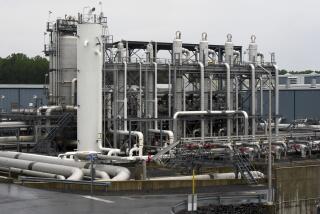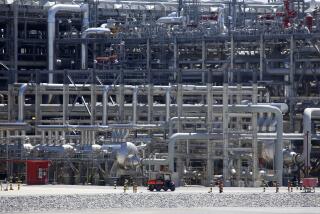Sempra Sees LNG as a Liquid Asset
- Share via
One of the hottest trends in the energy business involves a process that is all about coldness -- minus 260 degrees, to be exact.
That’s the temperature at which natural gas becomes a liquid, and that opens a world of possibilities for transporting gas around the globe. When cooled to a liquid, gas can be transported in cryogenic tankers, shipped across oceans and regasified at special terminals.
No longer is natural gas limited to overland pipeline distribution.
Sempra Energy Inc. Chairman Stephen L. Baum, among others, saw liquefied natural gas as a new growth industry, one that could answer America’s need for moderately priced basic energy.
Baum figured that gas prices would stay high as soaring use of the environmentally clean fuel in North America outran production of new supplies. But he also knew that natural gas resources are abundant elsewhere in the world, in Indonesia and the Persian Gulf states of Qatar and Oman, as well as in Russia and several West African countries.
And Sempra, an energy trader and supplier and parent of the utilities Southern California Gas and San Diego Gas & Electric, faces a need for natural gas to supply three power plants being built in Bakersfield, Phoenix and Mexicali, Mexico.
So over a year ago Baum applied for a permit for Sempra to build a liquefied natural gas terminal at Costa Azul, in Baja California, Mexico, and started negotiating to import supplies from Indonesia. In February, Sempra also bought the rights to build a $700-million LNG terminal in Cameron, La. In September it received a permit to go ahead with that facility, which will import 1.5 billion cubic feet per day of natural gas by 2007.
Last week marked a fulfillment of Sempra’s plans, as it signed an agreement with a division of Royal Dutch/Shell Group to share the cost of the $600-million project at Costa Azul and received the permit to go ahead with construction. That plant, also starting in 2007, will bring 500 million cubic feet a day of new gas into California -- more than 8% of the state’s usage.
Sempra was not alone. After a year of negotiations with the national petroleum company of Qatar, Exxon Mobil Corp., the world’s largest energy company, signed an agreement in October to develop a $12-billion LNG system. That operation would deliver 2 billion cubic feet a day of natural gas to the U.S. starting in 2008. The size of the Exxon Mobil-Qatar project, which will supply 2% of total U.S. natural gas, is unprecedented. Huge special tankers will be developed to transport the fuel to ports in the Texas-Louisiana Gulf Coast region. Use of man-made terminals out in gulf waters is being studied.
What’s going on is the opening of the U.S. as a committed importer of liquefied natural gas. Today, LNG supplies less than 2% of annual U.S. use of the fuel; within a decade, it will supply 10% of U.S. needs. Energy Secretary Spencer Abraham told delegates from 21 countries at a summit meeting in Washington the week before Christmas: “LNG is indispensable to meeting our future energy requirements.”
LNG no longer is a novelty in the rest of the world. Liquefied Algerian gas supplies electric generating and industrial plants in Western Europe, and Indonesian gas supplies electric utilities in Japan. But now a big LNG business is dawning in the U.S.
“Ten new systems of liquefaction-transportation-and-regasification will be built in the next decade in North America, three or four in the next few years,” predicts Ira Joseph, an analyst at Pira Energy Group, a New York firm that has tracked global energy for more than 50 years. “What is occurring is comparable to the shift 40 years ago when crude oil went from a predominantly domestic fuel to a worldwide commodity.”
That will mean a lot of business for companies that construct LNG facilities. Chicago Bridge & Iron Co. is the world’s largest builder of the cryogenic tanks that hold LNG in its liquid state. Fluor Corp., of Aliso Viejo, and the Houston-based Brown & Root division of Halliburton Inc. build liquefaction and regasification facilities.
Ultimately, the price of natural gas, which has become a crucial cost factor for homeowners as well as industry, could moderate with the growth of LNG. Right now, thanks to the early onset of winter across the U.S., natural gas is trading at sky high prices -- $6.70 per thousand cubic feet. But over the long term, says Sempra’s Baum, “we see the price ranging round $3.50.... That’s a level that will support investment in LNG systems.”
Even that $3.50 price is two to three times the average for natural gas over the last three decades. And it equates to $12 to $13 per thousand cubic feet in your gas bill for heating your home or as a fuel component to generate your electricity.
Time was, four or five decades ago, when gas was seen as a cheap waste material, costing pennies per thousand cubic feet. Californians heated their swimming pools with it. Then, in the 1970s, demand for natural gas grew, as did its price, and Californians discovered cheaper ways to heat their homes and swimming pools. Greater use of LNG will ensure availability of gas, but at prices higher than they used to be -- so conservation will continue as a way of life.
But as for the new growth industry, the cost of providing LNG facilities has discouraged some. Last week, El Paso Natural Gas Corp., sold to Conoco Phillips Corp. its interest in a regasification terminal in Texas. In February, Dynegy Inc. sold its interest in the Cameron, La., site to Sempra.
The energy giants, such as Exxon Mobil, ChevronTexaco and BP undoubtedly will be major factors in LNG because they possess capital in abundance.
But relatively small Sempra, a company with $6 billion in annual revenue, also stands ready to emerge as a new kind of company -- an LNG refiner -- because it had foresight and took bold action.
James Flanigan can be reached at jim.flanigan @latimes.com
More to Read
Inside the business of entertainment
The Wide Shot brings you news, analysis and insights on everything from streaming wars to production — and what it all means for the future.
You may occasionally receive promotional content from the Los Angeles Times.










